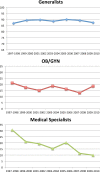Trends and quality of care in outpatient visits to generalist and specialist physicians delivering primary care in the United States, 1997-2010
- PMID: 24567201
- PMCID: PMC4026490
- DOI: 10.1007/s11606-014-2808-y
Trends and quality of care in outpatient visits to generalist and specialist physicians delivering primary care in the United States, 1997-2010
Abstract
Background: Although many specialists serve as primary care physicians (PCPs), the type of patients they serve, the range of services they provide, and the quality of care they deliver is uncertain.
Objective: To describe trends in patient, physician, and visit characteristics, and compare visit-based quality for visits to generalists and specialists self-identified as PCPs.
Design: Cross-sectional study and time trend analysis.
Data: Nationally representative sample of visits to office-based physicians from the National Ambulatory Medical Care Survey, 1997-2010.
Main measures: Proportions of primary care visits to generalist and specialists, patient characteristics, principal diagnoses, and quality.
Key results: Among 84,041 visits to self-identified PCPs representing an estimated 4.0 billion visits, 91.5 % were to generalists, 5.9 % were to medical specialists and 2.6 % were to obstetrician/gynecologists. The proportion of PCP visits to generalists increased from 88.4 % in 1997 to 92.4 % in 2010, but decreased for medical specialists from 8.0 % to 4.8 %, p = 0.04). The proportion of medical specialist visits in which the physician self-identified as the patient's PCP decreased from 30.6 % in 1997 to 9.8 % in 2010 (p < 0.01). Medical specialist PCPs take care of older patients (mean age 61 years), and dedicate most of their visits to chronic disease management (51.0 %), while generalist PCPs see younger patients (mean age 55.4 years) most commonly for new problems (40.5 %). Obstetrician/gynecologists self-identified as PCPs see younger patients (mean age 38.3 p < 0.01), primarily for preventive care (54.0 %, p < 0.01). Quality of care for cardiovascular disease was better in visits to cardiologists than in visits to generalists, but was similar or better in visits to generalists compared to visits to other medical specialists.
Conclusions: Medical specialists are less frequently serving as PCPs for their patients over time. Generalist, medical specialist, and obstetrician/gynecologist PCPs serve different primary care roles for different populations. Delivery redesign efforts must account for the evolving role of generalist and specialist PCPs in the delivery of primary care.
Figures
References
Publication types
MeSH terms
Grants and funding
LinkOut - more resources
Full Text Sources
Other Literature Sources



